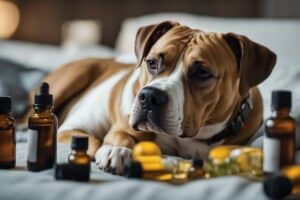Dealing with a dog ear yeast infection can be worrisome, but we’re here to provide you with tips on how to manage this common issue from the comfort of your home.
When our furry friends start scratching their ears or shaking their heads more than usual, it’s a cue for us to check on their ear health.
Symptoms like redness, a foul odor, or a noticeable discharge often point to a yeast infection, a condition that thrives in the warm, moist environment of a dog’s ear canal.

Fortunately, there are several home remedies we can use to help our pooches feel better.
We can start by keeping their ears clean and dry, especially after baths or swimming, which can help prevent infections from taking hold.
For an infection that’s already present, we might treat all affected areas with natural substances like coconut oil, which has been shown to have antifungal properties and can soothe the skin.
It’s essential, however, to approach these home treatments with care.
If symptoms persist or if we’re unsure about the severity of the infection, consulting with a vet is always the best course of action.
They can provide a definitive diagnosis and recommend more specific treatments to ensure our dog’s ear health is restored promptly.
Identifying Dog Ear Yeast Infections

Before we dive into the specifics, let’s clarify that recognizing the signs of a yeast infection in your dog’s ears is crucial for prompt and effective treatment.
Symptoms and Signs
Yeast infections can be particularly uncomfortable for our furry friends.
If your dog is experiencing a yeast infection in their ears, you may notice the following:
- Odor: An unusual, often musty or sweet smell emanating from your dog’s ears.
- Discharge: Look for a brownish or yellowish discharge.
It might be waxy or crusty and can accumulate inside the ear canal.
- Redness: The skin inside the ear might be inflamed and red, sometimes spreading to the ear flap.
- Itching: Your dog may scratch their ear incessantly or shake their head frequently in an attempt to relieve discomfort.
Breeds Prone to Yeast Infections
Some dog breeds are more susceptible to ear yeast infections due to their ear structure and coat type.
Among these, three breeds stand out:
- Cocker Spaniels: Their floppy ears provide a warm, moist environment ideal for yeast growth.
- Basset Hounds: Similar to Cocker Spaniels, their long, droopy ears create a tucked-away space for yeast to thrive.
- Poodles: Their thick, curly hair can trap moisture inside the ear canal, encouraging yeast overgrowth.
Home Care Essentials

When we’re tackling a dog ear yeast infection at home, it’s crucial to start with the right cleaning technique and then follow up with effective home remedies.
Let’s ensure we do it safely and effectively to provide our furry friends with some relief.
Proper Ear Cleaning Techniques
Materials You’ll Need:
- Cotton balls or gauze
- Veterinarian-approved ear cleaning solution
- Clean towel
Steps for Cleaning:
- Gently hold the tip of your dog’s ear and lift upward to straighten the ear canal.
- Squirt the cleaning solution into the ear canal, filling it until it’s almost full, but be careful not to overfill.
- Massage the base of the ear gently for about 20-30 seconds to break up the debris and wax inside.
- Step back and allow your dog to shake its head. This helps bring the loosened debris to the outer ear.
- Wipe away the loosened debris and excess solution gently using cotton balls or gauze.
- Dry the ear thoroughly with a clean towel.
Avoid inserting anything deep into the ear canal, and never use cotton swabs, as this can push debris further in or damage the ear.
Recommended Home Remedies
Coconut Oil:
Rich in antifungal properties, coconut oil can be carefully applied to the inside flap of your dog’s ears, but not deep into the ear canal.
Warm the oil to a safe temperature before applying it with a cotton ball.
Apple Cider Vinegar:
Apple cider vinegar can be mixed with equal parts water to create a diluted solution that helps to change the ear environment and make it less prone to yeast.
Only use if there are no open wounds in the ear.
Peroxide:
While peroxide can be used for cleaning, it should be done with great caution, as it can sometimes irritate the sensitive skin in the ears.
Using these techniques and remedies, we can create a safe and soothing home care routine for our dogs suffering from ear yeast infections.
Remember, if symptoms persist, it’s important to consult a veterinarian.
Diet and Nutrition

When we tackle ear yeast infections in dogs, it’s important to consider that what they eat can significantly impact their health.
Adjusting your dog’s diet helps address the yeast overgrowth from the inside out.
Foods to Avoid
To help our pups combat yeast overgrowth, we must be cautious about their diet, steering clear of ingredients that can exacerbate the condition.
Here’s a rundown:
- High-sugar foods: Since yeast thrives on sugar, avoid foods that are high in carbohydrates which convert to sugar.
- Foods causing allergies: If your dog has food allergies, it’s crucial to identify and eliminate those foods, as allergies can lead to yeast flare-ups.
Beneficial Foods and Supplements
On the flip side, certain foods and supplements can be quite beneficial:
- Probiotics: Introducing probiotics can help restore the natural balance of microbes in your dog’s body, often available as supplements.
- Low-carbohydrate foods: Foods low in carbohydrates can limit the food source for yeast, helping to keep it in check.
- Water: Ensuring your dog has access to plenty of clean, fresh water is essential for overall health and can help flush out toxins.
By incorporating these dietary changes and closely monitoring your dog’s reaction to different foods, we can create a supportive environment to manage a yeast infection effectively.
Remember, when we make changes to our dog’s diet, it’s always best to consult with a veterinarian.
When to Consult a Vet

When managing your dog’s ear yeast infection at home, it’s crucial for us to know when it’s time to consult a vet.
Certain symptoms and scenarios demand professional veterinary attention to prevent further complications and to ensure the best care for our furry friend.
Recognizing Complications
Persistent Pain and Discomfort: If your dog continues to show signs of pain such as whining, scratching, or shaking its head despite home treatments, it’s time to visit the vet.
Worsening Symptoms: Any worsening of symptoms – like increased redness, swelling, or discharge – should be a clear signal for us to seek veterinary assistance.
Unusual Behavior: Dogs in pain may become more aggressive or withdrawn.
If you notice significant changes in your dog’s behavior, this could indicate that the ear infection is more serious than initially thought.
No Improvement: Even with appropriate home care, if there’s no improvement within a few days, a trip to the vet is necessary.
A vet can use special tools like an otoscope to examine your dog’s ear canal thoroughly.
Diagnosis and Treatment Plan: Only a vet can provide an accurate diagnosis and craft a tailored treatment plan.
This may include prescription medication or other interventions that we simply cannot provide at home.
Remember, prompt veterinary care can prevent an ear infection from turning into a painful ordeal for your dog.
Don’t hesitate to seek professional advice to ensure the best outcome for your pet’s health.
Prevention and Maintenance
Preventing ear yeast infections in our dogs starts with a two-pronged approach centered around environmental considerations and regular ear care.
By managing these factors diligently, we can keep our pups’ ears healthy and avoid the discomfort of infections.
Environmental Considerations
We know that our dogs’ environment plays a significant role in the health of their ears.
To prevent yeast infections, it’s crucial to keep our living spaces clean and dry, as yeast thrives in moist conditions.
-
Humidity Control: We aim to maintain a moderately dry environment.
This could mean using dehumidifiers in damp climates or rooms, especially during wet seasons.
-
Clean Bedding: We ensure that our dogs’ bedding, crates, and favorite resting areas are washed regularly to prevent the buildup of yeast and bacteria.
When our dogs have allergies, it’s important to manage them proactively to prevent ear infections.
If we know certain allergens trigger our dog’s symptoms, we’ll limit their exposure as much as possible.
Regular Ear Care
Establishing a routine for ear care is essential in keeping our furry friends happy and infection-free.
-
Routine Checks: We check our dogs’ ears regularly for signs of infection like redness, swelling, or unusual odors.
These checks become a part of our regular grooming schedule.
-
Proper Ear Cleaning: Using a veterinarian-approved ear cleaner, we gently clean our dogs’ ears to remove any buildup.
This helps maintain a proper ear environment that’s unfavorable for yeast growth.
For those dogs with a predisposition to ear problems—whether due to their breed, allergies, or a history of ear mites—it’s important to integrate regular ear cleaning into their care routine.
Immunity also plays a key role; a robust immune system can ward off ear infections, so a well-balanced diet and adequate exercise are part of our preventative strategy.
By focusing on these prevention and maintenance strategies, we can significantly reduce the risk of ear yeast infections in our dogs, ensuring they remain comfortable and healthy.















